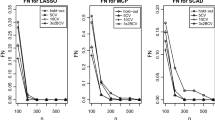Abstract
\(5\times 2\) cross-validated F-test based on independent five replications of 2-fold cross-validation is recommended in choosing between two classification learning algorithms. However, the reusing of the same data in a \(5\times 2\) cross-validation causes the real degree of freedom (DOF) of the test to be lower than the F(10, 5) distribution given by (Neural Comput 11:1885–1892, [1]). This easily leads the test to suffer from high type I and type II errors. Random partitions for \(5\times 2\) cross-validation result in difficulty in analyzing the DOF for the test. In particular, Wang et al. (Neural Comput 26(1):208–235, [2]) proposed a new blocked \(3 \times 2\) cross-validation, that considered the correlation between any two 2-fold cross-validations. Based on this, a calibrated balanced \(5\times 2\) cross-validated F-test following F(7, 5) distribution is put forward in this study by calibrating the DOF for the F(10, 5) distribution. Simulated and real data studies demonstrate that the calibrated balanced \(5\times 2\) cross-validated F-test has lower type I and type II errors than the \(5\times 2\) cross-validated F-test following F(10, 5) in most cases.
Similar content being viewed by others
References
Alpaydin E (1999) Combined \(5\times 2\) cv \(F\) test for comparing supervised classification learning algorithms. Neural Comput 11(8):1885–1892
Wang Y, Ruibo W, Huichen J, Jihong L (2014) Blocked \(3\times 2\) cross-validated t-test for comparing supervised classification learning algorithms. Neural Comput 26(1):208–235
Bengio Y, Grandvalet Y (2004) No unbiased estimator of the variance of \(K\)-fold cross-validation. J Mach Learn Res 5:1089–1105
Grandvalet Y, Bengio Y (2006) Hypothesis testing for cross-validation. Technical report. University of Montreal, Montreal
Markatou M, Tian H, Biswas S, Hripcsak G (2005) Analysis of variance of cross-validation estimators of the generalization error. J Mach Learn Res 6:1127–1168
Nadeau C, Bengio Y (2003) Inference for the generalization error. Mach Learn 52(3):239–281
Dietterich T (1998) Approximate statistical tests for comparing supervised classification learning algorithms. Neural Comput 10(7):1895–1924
Yildiz OT (2013) Omnivariate rule induction using a novel pairwise statistical test. IEEE Trans Knowl Data Eng 25:2105–2118
Chen W, Gallas BD, Yousef WA (2012) Classifier variability: accounting for training and testing. Pattern Recognit 45:2661–2671
Demsar J (2006) Statistical comparisons of classifiers over multiple data sets. J Mach Learn Res 7:1–30
Garcia S, Herrera F (2008) An extension on “statistical comparisons of classifiers over multiple data sets” for all pairwise comparisons. J Mach Learn Res 9:2677–2694
Ulas A, Yildiz OT, Alpaydin E (2012) Cost-conscious comparison of supervised learning algorithms over multiple data sets. Pattern Recognit 45:1772–1781
Wang Y, Jihong L, Yanfang L (2015) Measure for data partitioning in \(m\times 2\) cross-validation. Pattern Recognit Lett 65:211–217
Yildiz OT, Alpaydin E (2006) Ordering and finding the best of \(K>2\) supervised learning algorithms. IEEE Trans Pattern Anal Mach Intell 28:392–402
Bouckaert RR, Frank E (2004) Evaluating the replicability of significance tests for comparing learning algorithms. PAKDD, LNAI 3056, 3–12
Bouckaert RR (2003) Choosing between two learning algorithms based on calibrated tests. In: Proceedings of the twentieth international conference on machine learning. pp 51–58
Burges C (1998) A tutorial on support vector machines for pattern recognition. Data Min Knowl Discov 2(2):1–47
Brenneman WA, Nair VN (2001) Methods for identifying dispersion effects in unreplicated factorial experiments: a critical analysis and proposed strategies. Technometrics 43:388–404
Satterhwaite FE (1946) An approximate distribution of estimates of variance components. Biom Bull 2:110–114
Acknowledgements
This work was supported by National Natural and Social Science Funds of China (61503228, 16BTJ034), Natural Science Fund of Shanxi Province (201601D011046) and Special Program for Applied Research on Super Computation of the NSFC-Guangdong Joint Fund (the second phase).
Author information
Authors and Affiliations
Corresponding author
Appendix
Appendix
Proof of proposition
Denoting \(U=(\hat{\mu }_{B_1}^{(1)}, \hat{\mu }_{B_2}^{(1)}, \hat{\mu }_{B_1}^{(2)}, \hat{\mu }_{B_2}^{(2)}, \ldots , \hat{\mu }_{B_1}^{(5)}, \hat{\mu }_{B_2}^{(5)})^{T}\), we have \(U\sim N(0, \sigma ^{2}\Sigma )\) from the assumption of Proposition, where
The eigenvalues of \(\Sigma \) are obtained easily from \(|\lambda I-\Sigma |=0\): \(\lambda _{1}=1-\rho _{1}\) with multiplicity 5, \(\lambda _{6}=-2\rho _{2}+\rho _{1}+1\) with multiplicity 4, and \(\lambda _{10}=\rho _{1}+8\rho _{2}+1\). Thus, we can conclude that real symmetric matrix \(\Sigma \) represents a positive definite matrix when \(0\le \rho _{1}\le \rho _{2}<0.50\). We can also conclude that \(\Sigma ^{\frac{1}{2}}\) is a positive definite matrix from the decomposition \(\Sigma =\Sigma ^{\frac{1}{2}} \Sigma ^{\frac{1}{2}}\).
Let \(U_{1}=U/\sigma , Z=\Sigma ^{-\frac{1}{2}}U_{1}\), then we have \(U_{1}\sim N(0,\Sigma ), Z\sim N(0, I_{10})\) and obviously \(U_{1}^{T}U_{1}=Z^{T}\Sigma Z\).
An orthogonal matrix exists for each n order real symmetric matrix such that the matrix can be diagonalized. Thus, an orthogonal matrix T exists such that \(T\Sigma T^{T}=\Lambda \), i.e., \(\Sigma =T^{T}\Lambda T, \) where \(\Lambda \) is a diagonal matrix, and its element is the eigenvalue of \(\Sigma \).
We know that \(TZ\sim N(0, I_{10})\) from the properties of the orthogonal matrix, then \(U_{1}^{T}U_{1}=Z^{T}\Sigma Z=Z^{T}T^{T} \Lambda TZ=\sum _{i=1}^{10}\lambda _{i}\eta _{i}^{2}\). Thus, \(U_{1}^{T}U_{1}\) approximately follows an \(C \chi ^{2}(f)\) distribution because \(\sum _{i=1}^{10}\lambda _{i}\eta _{i}^{2}\) approximately follows \(C \chi ^{2}(f)\) distribution, where \(\lambda _{i}\) denotes the eigenvalue of \(\Sigma \), \(\eta _{i}\) is the i-th element of matrix TZ, and
Note \(\sum _{i=1}^{10}\lambda _{i}=10, \sum _{i=1}^{10}\lambda _{i}^{2}=10(1+\rho _{1}^{2}+8\rho _{2}^{2}), fC=\sum _{i=1}^{10}\lambda _{i}=10. \)
Moreover, we have \(Var(\hat{\mu }_{B_1}^{(i)}-\hat{\mu }_{B_2}^{(i)})=2(1-\rho _{1})\sigma ^{2}, Cov(\hat{\mu }_{B_1}^{(i)}-\hat{\mu }_{B_2}^{(i)},\hat{\mu }_{B_1}^{(i')}-\hat{\mu }_{B_2}^{(i')}) = (\rho _{2}-\rho _{2}-\rho _{2}+\rho _{2})\sigma ^{2}=0\) for \(i\ne i'\). If letting \(U_{2}=((\hat{\mu }_{B_1}^{(1)}-\hat{\mu }_{B_2}^{(1)})/\sigma , \ldots , (\hat{\mu }_{B_1}^{(5)}-\hat{\mu }_{B_2}^{(5)})/\sigma )\), then \(U_{2} \sim N(0,\Sigma _{2}), \) and \(U_{2}^{T}U_{2} \sim 2(1-\rho _{1}) \chi ^{2}(5)\), where
These result in
We know that
where \(\hat{\mu }_B^{(i)}=\frac{\hat{\mu }_{B_1}^{(i)}+\hat{\mu }_{B_2}^{(i)}}{2}\).
Therefore,
where \(f=\frac{10}{1+\rho _{1}^{2}+8\rho _{2}^{2}}.\) \(\square \)
Rights and permissions
About this article
Cite this article
Wang, Y., Li, J. & Li, Y. Choosing Between Two Classification Learning Algorithms Based on Calibrated Balanced \(5\times 2\) Cross-Validated F-Test. Neural Process Lett 46, 1–13 (2017). https://doi.org/10.1007/s11063-016-9569-z
Published:
Issue Date:
DOI: https://doi.org/10.1007/s11063-016-9569-z




